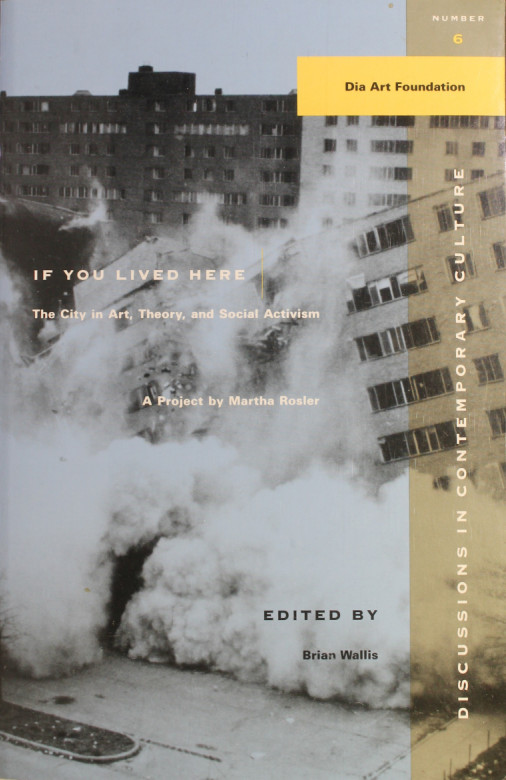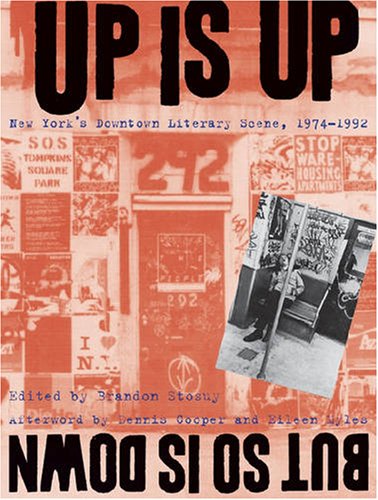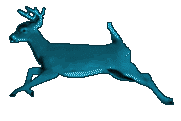If You Lived Here: The City in Art, Theory, and Social Activism: A Project by Martha Rosler (1991)
Filed under book | Tags: · activism, art, city, gentrification, home, housing, new york, public space, theory

“This volume documents the present crisis in American urban housing policies and portrays how artists within the context of neighborhood organizations, have fought against government neglect, shortsighted housing policies and unfettered real estate speculation. Through essays, photographs, symposiums, architectural plans and the reproduction of works from the series of exhibitions organized by Martha Rosler, the book serves a number of functions: it’s a practical manual for community organizing; a history of housing and homelessness in New York City and around the country; and an outline of what a humane housing policy might encompass for the American city.” (from the back cover)
With contributions by Christine Benglia Bevington, Marie Annick Brown, Andrew Byard, Cenén, The Chinatown History Project, Clinton Coalition of Concern, Rosalyn Deutsche, Dan Graham and Robin Hurst, Alexander Kluge, The Mad Housers, Tony Masso, The Nation, Richard Plunz, William Price, Yvonne Rainer, Mel Rosenthal, Allan Sekula, Camilo José Vergara, and Dan Wiley.
Edited by Brian Wallis
First published by Bay Press, Seattle, and Dia Art Foundation, New York, 1991
First New Press printing, 1999
Discussions in Contemporary Culture series, 6
ISBN 156584498X, 9781565844988
x+312 pages
via Dubravka
Artist’s archive project, 2009
Artist
Publisher (New Press)
Publisher (Dia)
Exhibition
WorldCat
PDF (75 MB)
Comment (0)Brandon Stosuy (ed.): Up Is Up, But So Is Down: New York’s Downtown Literary Scene, 1974-1992 (2006)
Filed under book | Tags: · 1970s, 1980s, 1990s, art, diy, history of literature, literature, music, new york, poetry, publishing, theatre

“Sometime after Andy Warhol’s heyday but before Soho became a tourist trap, a group of poets, punk rockers, guerilla journalists, graffiti artists, writers, and activists transformed lower Manhattan into an artistic scene so diverse it became known simply as “Downtown.“ Willfully unpolished and subversively intelligent, figures such as Spalding Gray, Kathy Acker, Richard Hell, David Wojnarowicz, Lynne Tillman, Miguel Piñero, and Eric Bogosian broke free from mainstream publishing to produce a flood of fiction, poetry, experimental theater, art, and music that breathed the life of the street.
The first book to capture the spontaneity of the Downtown literary scene, Up Is Up, But So Is Down collects more than 125 images and over 80 texts that encompass the most vital work produced between 1974 and 1992. Reflecting the unconventional genres that marked this period, the book includes flyers, zines, newsprint weeklies, book covers, and photographs of people and the city, many of them here made available to readers outside the scene for the first time. The book’s striking and quirky design—complete with 2-color interior—brings each of these unique documents and images to life.
Brandon Stosuy arranges this hugely varied material chronologically to illustrate the dynamic views at play. He takes us from poetry readings in Alphabet City to happenings at Darinka, a Lower East Side apartment and performance space, to the St. Mark’s Bookshop, unofficial crossroads of the counterculture, where home-printed copies of the latest zines were sold in Ziploc bags. Often attacking the bourgeois irony epitomized by the New Yorker’s short fiction, Downtown writers played ebulliently with form and content, sex and language, producing work that depicted the underbelly of real life.
With an afterword by Downtown icons Dennis Cooper and Eileen Myles, Up Is Up, But So Is Down gathers almost twenty years of New York City’s smartest and most explosive—as well as hard to find—writing, providing an indispensable archive of one of the most exciting artistic scenes in U.S. history.”
With an afterword by Dennis Cooper and Eileen Myles
Publisher NYU Press, 2006
ISBN 9780814740118
500 pages
Downtown Collection at NYU’s Fales Library
Reviews: Ed Halter (Village Voice, 2006), Meghan O’Rourke (New York Times, 2006), Tim W. Brown (Columbia Journal of American Studies, n.d).
Commentary: Cynthia Carr (New York Times, 2006), Peter Cherches (2006).
PDF (39 MB, updated on 2019-8-23)
Comments (2)Benjamin Piekut: Experimentalism Otherwise: The New York Avant-Garde and Its Limits (2011)
Filed under book | Tags: · avant-garde, experimental music, jazz, music, music history, new york, performance

“In Experimental Otherwise, Benjamin Piekut takes the reader into the heart of what we mean by “experimental” in avant-garde music. Focusing on one place and time–New York City, 1964–Piekut examines five disparate events: the New York Philharmonic’s disastrous performance of John Cage’s Atlas Eclipticalis; Henry Flynt’s demonstrations against the downtown avant-garde; Charlotte Moorman’s Avant Garde Festival; the founding of the Jazz Composers Guild; and the emergence of Iggy Pop. Drawing together a colorful array of personalities, Piekut argues that each of these examples points to a failure and marks a limit or boundary of canonical experimentalism. What emerges from these marginal moments is an accurate picture of the avant-garde, not as a style or genre, but as a network defined by disagreements, struggles, and exclusions.”
Publisher University of California Press, 2011
ISBN 0520948424, 9780520948426
296 pages
Reviews: Thomas Fogg (Current Musicology, 2011), Clemens Gresser (Notes, 2012), Molly McGlone (Twentieth-Century Music, 2013), Jeremy Grimshaw (American Music, 2014).
PDF (updated on 2020-5-3)
Comment (0)
